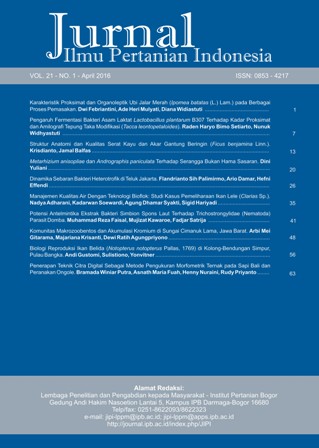Pengaruh Fermentasi Bakteri Asam Laktat Lactobacillus plantarum B307 Terhadap Kadar Proksimat dan Amilografi Tepung Taka Modifikasi (Tacca leontopetaloides)
Abstract
Tacca (Tacca leontopetaloides) is plant that grows in coastal areas and high salinity, especially in the south coast of West Java. Tacca tubers have high content of carbohydrate, but it also contains some toxic compounds such as: taccaline, β – sitosterol, alcohol cerylic, and steroid sapogenin that are harmful for health. Fermentation on tacca tubers can change amylograph properties and proximate levels of modified tacca flour and reduce it toxic compounds. This study aimed at determining the effects of lactic acid bacteria (LAB) Lactobacillus plantarum B307 fermentation on the proximate levels and amylograph characteristics of modified tacca flour. Moisture and ash content of modified tacca flour still meet the requirements of SNI. Fermentation LAB Lactobacillus plantarum B307 led to increased levels of protein and lactic acid in the modified tacca flour, but it decreased pH value and carbohydrate content. Based on the analysis of amylograph, it can be concluded that tacca flour control without fermentation has the best gelatinization profile because it has good ability of setback viscosity.Downloads
References
Abiodun OA, Akinoso R. 2014. Effect of delayed harvesting and pre-treatment methods on the antinutritional contents of trifoliate yam flour. Food Chemistry. 146: 515-520. http://doi.org/bdzw
Alariya SS, Sethi S, Gupta S, Lal GB. 2013. Amylase activity of a starch degrading bacteria isolated from soil. Archives of Applied Science Research. 5(1): 15-24.
Amandikwa C, Iwe MO, Uzomah A, Olawuni AI. 2015. Physico-chemical properties of wheat-yam flour composite bread. Nigerian Food Journal. 33(1): 12-17. http://doi.org/bdzx
[AOAC] Association of Official Analytical Chemists. 2005. Official methods of analysis of association of official analytical chemists (18th ed.) Methods 942.05, 990.03, 920.39, 962.09 Gaithersburg, MD.
Bhanwar S, Ganguli A. 2014. α-amylase and β-galactosidase production on potato starch waste by Lactococcus lactis subsp lactis isolated from pickled yam. Journal of Scientific & Industrial Research. 73: 324-330.
[BSN] Badan Standarisasi Nasional. 2011. Tepung mocaf sebagai bahan makanan SNI 7622-2011. Jakarta (ID): BSN.
Huang H, Jiang Q, Chen Y, Li X, Mao X, Chen X, Huang L, Gao W. 2016. Preparation, physicoechemical characterization and biological activities of two modified starches from yam (Dioscorea Opposita Thunb.). Food Hydrocolloids. 55: 244-253. http://doi.org/bdzz
Kumoro AC, Hartati I. 2015. Microwave Assisted Extraction of Dioscorin from Gadung (Dioscorea hispida Dennst) Tuber Flour. Procedia Chemistry. 14: 47-55. http://doi.org/bdz2
Kunle OO, Ibrahim YE, Emeje MO, Shaba S, Kunle Y. 2003. Extraction, Physicochemichal and Compaction Properties of Tacca Starch-a Potential Pharmaceutical Excipient. Starch. 55(7): 319-325. http://doi.org/chpdkm
Kusnandar F. 2010. Kimia Pangan Komponen Makro. Jakarta (ID): Dian Rakyat.
Kusumayanti H, Handayani NA, Santosa H. 2015. Swelling power and water solubility of cassava and sweet potatoes flour. Procedia Environmental Sciences. 23: 164-167. http://doi.org/bdz3
Manek RV, Kunle OO, Emeje MO, Builders P, Rao GVR, Lopez GP, Kolling WM. 2005. Physical, thermal and sorption profile of starch obtained from Tacca leontopetaloides. Starch. 57(2): 55-61. http://doi.org/cfmj8c
Marston K, Khouryieh H, Aramouni F. 2015. Evaluation of sorghum flour functionality and quality characteristics of gluten-free bread and cake as influenced by ozone treatment. Food Science and Technology International. 21(8): 631-640. http://doi.org/bdz4
Marston K, Khouryieh H, Aramouni F. 2016. Effect of heat treatment of sorghum flour on the functional properties of gluten-free bread and cake. LWT - Food Science and Technology. 65: 637-644. http://doi.org/bdz5
Moradi M, Shariati P, Tabandeh F, Yakhchali B, Khaniki GB. 2014. Screening and isolation of powerful amylolytic bacterial strains. International Journal of Current Microbiology and Applied Sciences. 3(2): 758-768.
Pokhrel B, Wanjare P, Singh S, Purushotham B, Kumara SM. 2013. Isolation, screening and characterization of promising alfa-amylase producing bacteria from sewage enriched soil. International Journal of Advanced Biotechnology and Research. 4(2): 286-290.
Ramón AP, Taschetto L, Lunelli F, Mezadri ET, Souza M, Foletto EL, Jahn SL, Kuhn RC, Mazutti MA. 2015. Ultrasound-assisted acid and enzymatic hydrolysis of yam (Dioscorea sp.) for the production of fermentable sugars. Biocatalysis and Agricultural Biotechnology. 4(1): 98-102. http://doi.org/bdz6
Reddy G, Altaf MD, Naveena BJ, Venkateshwar M, Kumar EV. 2008. Amylolytic bacterial lactic acid fermentation-A review. Biotechnology Advances. 26(1): 22-34. http://doi.org/c6m9ms
[SNI] Standar Nasional Indonesia. 1992. Cara uji makanan dan minuman. Jakarta (ID): Badan Standarisasi Nasional.
Trappey EF, Khouryieh H, Aramouni F, Herald T. 2015. Effect of sorghum flour composition and particle size on quality properties of gluten-free bread. Food Science and Technology International. 21(3): 188-202. http://doi.org/bdz7
Ukpabi UJ, Ukenye E, Olojede AO. 2009. Raw Material Potentials of Nigerian Wild Polynesian Arrowroot (Tacca leontopetaloides) Tubers and Starch. Journal of Food Technology. 7(4): 135-138.
Umoh EO, Iwe MO. 2014. Effects of Processing on the Nutrient Composition of False Yam (Icacina trichantha) Flour. Nigerian Food Journal. 32(2): 1-7. http://doi.org/bdz8
Winger M, Khouryieh H, Aramouni F, Herald TJ. 2014. Sorghum flour characterization and evaluation in gluten-free flour tortilla. Journal of Food Quality. 37(2): 95-106. http://doi.org/bdz9
This journal is published under the terms of the Creative Commons Attribution-NonCommercial 4.0 International License. Authors who publish with this journal agree to the following terms: Authors retain copyright and grant the journal right of first publication with the work simultaneously licensed under a Creative Commons Attribution-NonCommercial 4.0 International License. Attribution — You must give appropriate credit, provide a link to the license, and indicate if changes were made. You may do so in any reasonable manner, but not in any way that suggests the licensor endorses you or your use. NonCommercial — You may not use the material for commercial purposes.























